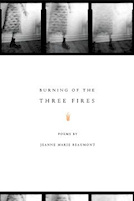nycBigCityLit.com the rivers of it, abridged


Reviews
Burning of the Three Fires by Jeanne Marie Beaumont

Burning of the Three Fires
by Jeanne Marie Beaumont
BOA Editions, 2010; 96 pages; $16.00
ISBN 978-1-934414-40-8, paper
http://www. www.boaeditions.org
Reviewed by Kryssa Schemmerling
Jeanne Marie Beaumont's third collection of poems, Burning of the Three Fires, opens with a question to the reader: "What is your favorite flower, favorite bird?/I really want you to tell me." The poem, aptly titled "Getting to Know You," continues:
Here's your cup of coffee, your violet-blue crayon,
your miniature iron, your hummingbird… ,
now, friend (if I may call you friend),
let's get to work.
This gesture of inclusiveness prefigures the rest of the book: Burning of the Three Fires is a grab-bag of different forms and styles—prose poems, found poems, object poems, ekphrasis, lists, monologues. A wordsmith in the truest sense, Beaumont bends, molds, manipulates, and cajoles words into all sorts of fresh and surprising shapes. Through it all, we are always aware of the poet at play, as she puts language through its paces with an almost childlike glee. Witness "Channeling Sylvia Plath: 8-Ball (Interrogation)," a literal transcript of a question-and-answer session with Sylvia Plath conducted through one of those plastic Magic 8-Balls found in toy stores: "Thank you. I think I've bothered you enough./YOU MAY RELY ON IT."
Plath, whom Beaumont invokes as a muse, is also the source for "[EXIT CORPSE]," a poem cobbled entirely out of sentences and phrases from The Bell Jar. And Plath appears yet again, indirectly, as a sort of unseen presence in "Dressing Table, 1963." An obsessive cataloguing of the battery of cosmetics and beauty aids employed by the pre-feminist woman, the poem is formatted on the page to subtly recall the shape of an old-fashioned vanity, with its "twin frosted lamps of diplomacy" and "pleated skirt."
In Burning of the Three Fires, Beaumont manages to have fun with words and sounds even when her subject matter moves into darker territory. Take, for instance, "Poor Shoddy." Like a tongue-twisting nursery rhyme, it delights in over-the-top alliteration: "She's nobody and knows it./She shudders, all shook up/in her shabby body/her shunned body." Yet the portrait it paints is touched with pathos. When Beaumont moves to direct address in the final lines, it's done so effortlessly that it goes practically unnoticed, but it's that shift which makes us feel sharply: " …the stab of an age-old jeer/that seems to call your name–/Cheap shoes! Cheap shoes!" It is here that we sense the poet merging with the "shadow lady" of the poem. Something similar happens, even more powerfully, at the conclusion of "Circumference," the final poem in the collection:
After you turn away
you grow afraid to look
back and find she's disappeared.
Look.
An old woman is here.
You have vanished.
Divided into three sections—Trinket, Alteration of Girl, and Rites—Burning of the Three Fires concerns itself with what it means to be female by examining, under a microscope, the outward, often devalued, trappings of femininity, its "trinkets." Here is "A Notion":
It was unfortunate, unfair that the rather hardy button had to be
dependent upon the weak, constantly fraying thread. A classic marriage of
unequals.
The coat itself was just a neutral background against which this drama of
thread
& button was played.
In another poem Beaumont writes of someone "who would retreat into domestic life to flourish unseen./…known to us now as Helen P., the first in her class to finish her apron."
Dolls, brides, fairytale heroines, and anorexics all make appearances, as Beaumont offers multiple views of womanhood from a variety of angles. Rather than overwhelming us with personal information, the poet dons various masks, peeking out from behind them to offer measured, tantalizing glimpses of what we imagine to be her inner state. The identification of writer with subject becomes explicit in one of the book's most haunting poems, "Broken Dolls Day," with more echoes of Plath in its violent imagery and staccato rhythms:
It is over. Around her those of the lost
screws, stuck eyes, detached
wires, burnt hair, punctured torso;
brother work, dog work, left out
in the rain. Played out.
O broken ones, we are
the careless world—forgive us
for we wore you as ourselves."
In poem after poem, Beaumont works as a kind of miniaturist. Focusing in on small, seemingly insignificant inanimate objects, she examines them in exquisite detail, bringing them to life, infusing them with radiance, as in "Oranges," with its meditation on a discarded rind flattened by traffic: "It made/me happy to think a fine orange coat could be tailored out of it by some tiny/orange-hide-using tribesman … " In the gorgeous "Mixed Tulips," about a deli bouquet "carried home with Sunday's heavy news-/paper," Beaumont takes us deep inside the flower, exploring its history, summoning its spirit:
"…you are by origin Ottoman,
tulips, you are the folded turbans
enwrapping the mind of the tulip god.
As you open I find the curved chambers
in which I would like to be carried from this world."
One comes away from this collection amazed at the poet's versatility and the breadth of her imagination. Beaumont can play it straight and quiet beautifully, but she isn't afraid to get a little silly, too. Eclectic, quirky, often dazzling, Burning of the Three Fires charms and seduces in its ability to shift, with impressive ease, between the playful and the sublime.
Kryssa Schemmerling holds an MFA in filmmaking from Columbia University. Her poems have been published or are forthcoming in 2River View; Big City Lit.com; and The Same. Her chapbook, Iris in, was a finalist in both the 2010 Slapering Hol Press and Black River chapbook contests. She teaches screenwriting at New York University's Tisch School of the Arts and lives in Brooklyn.